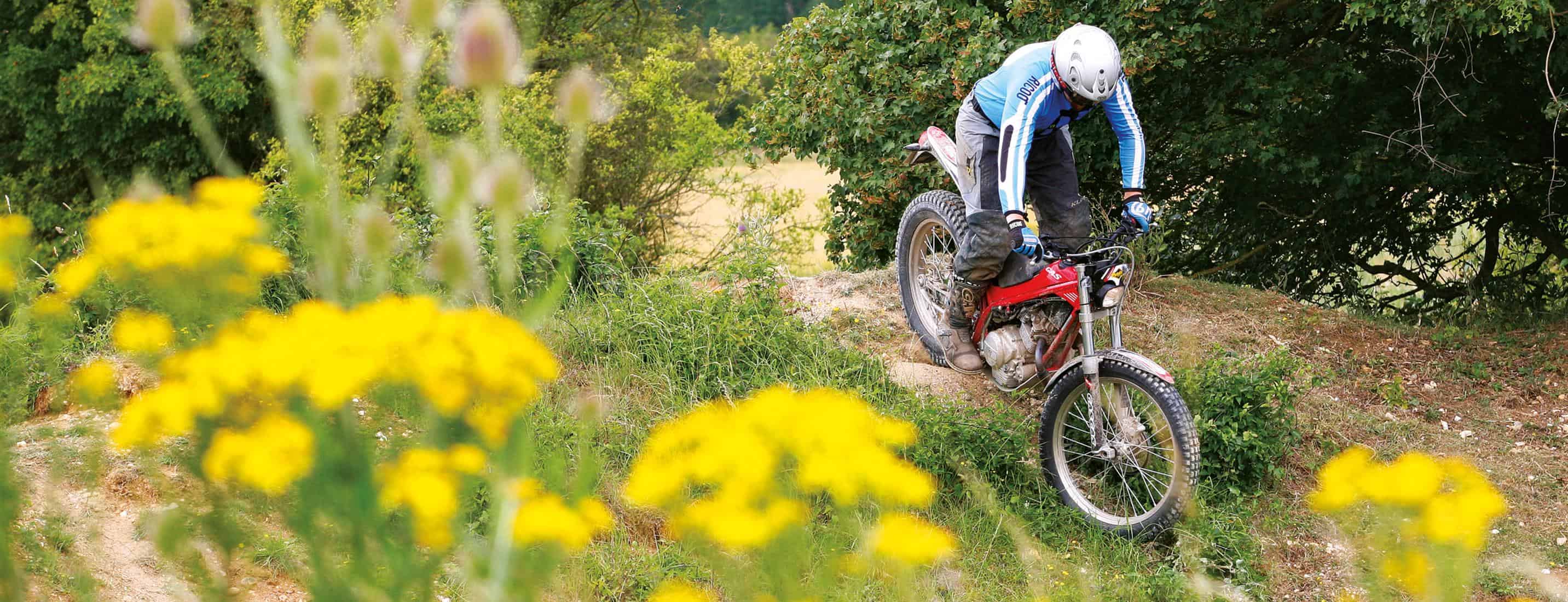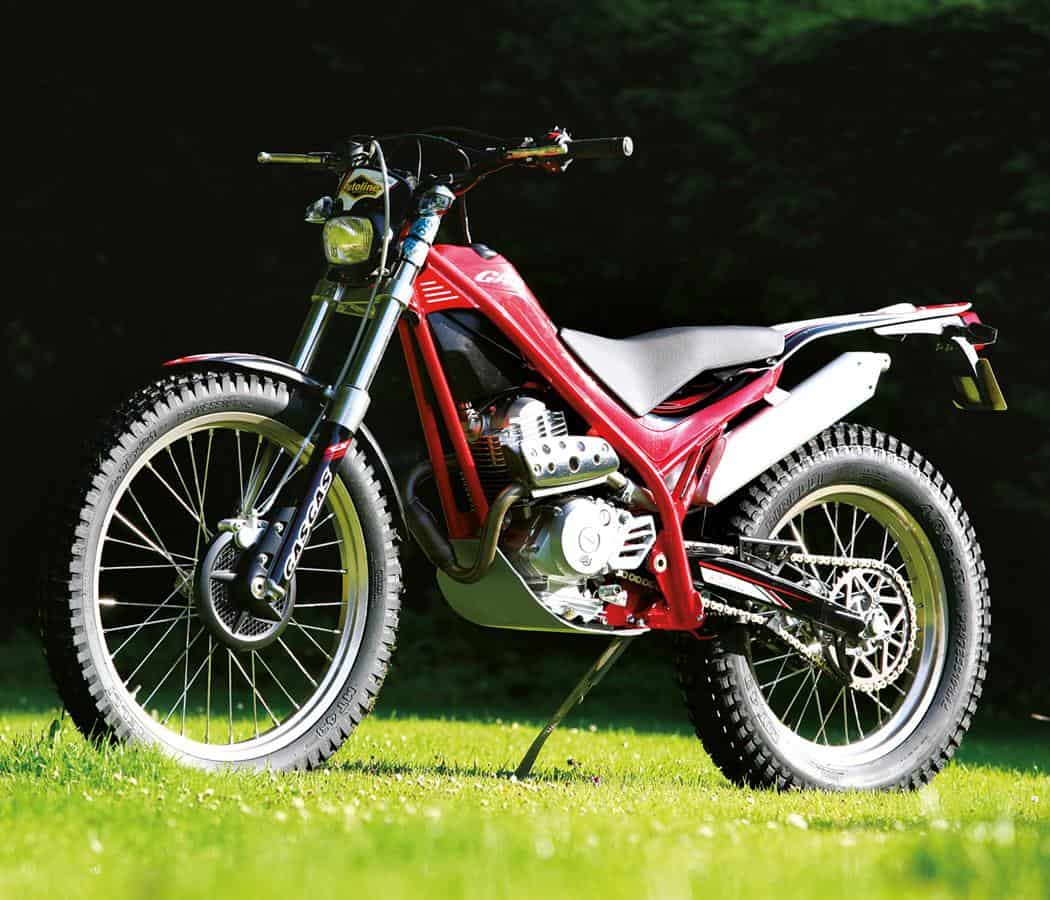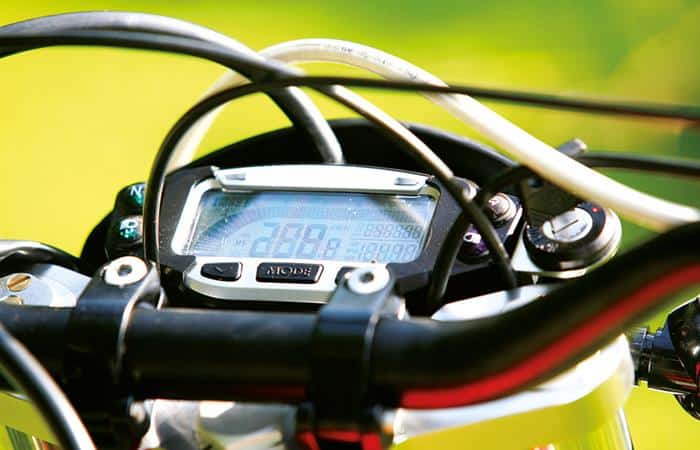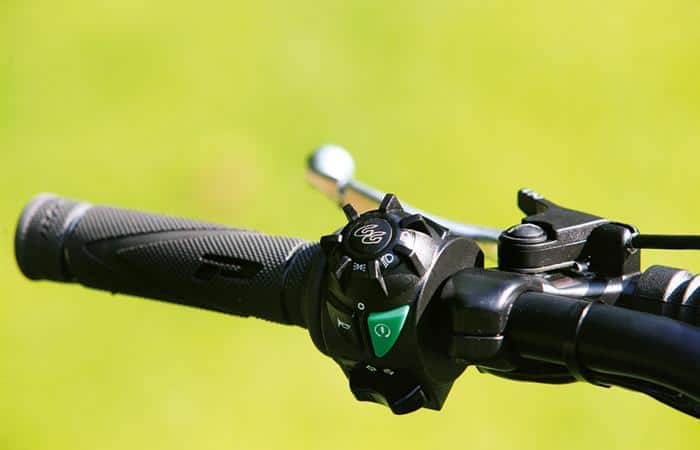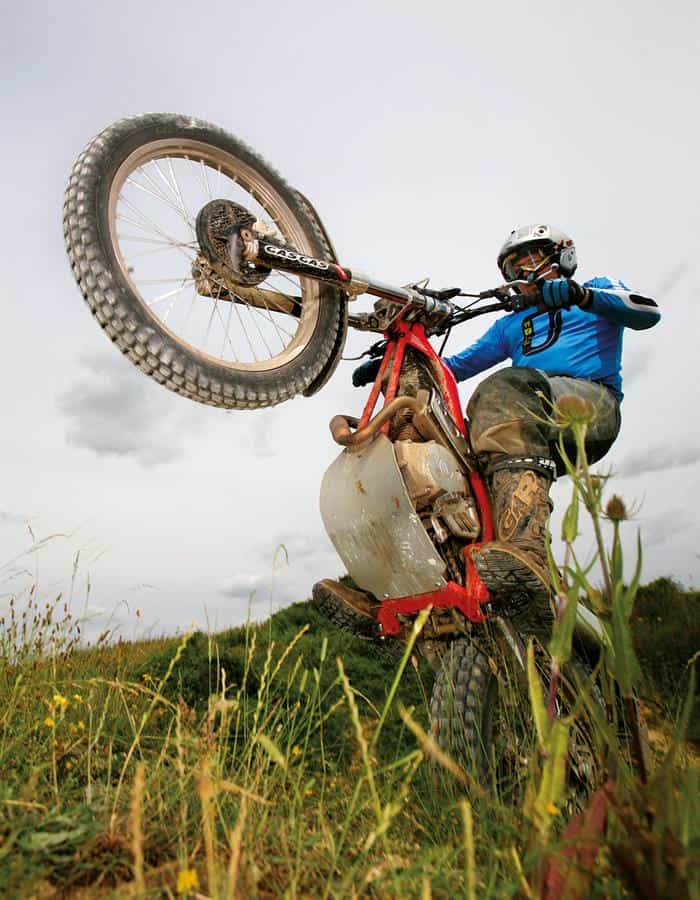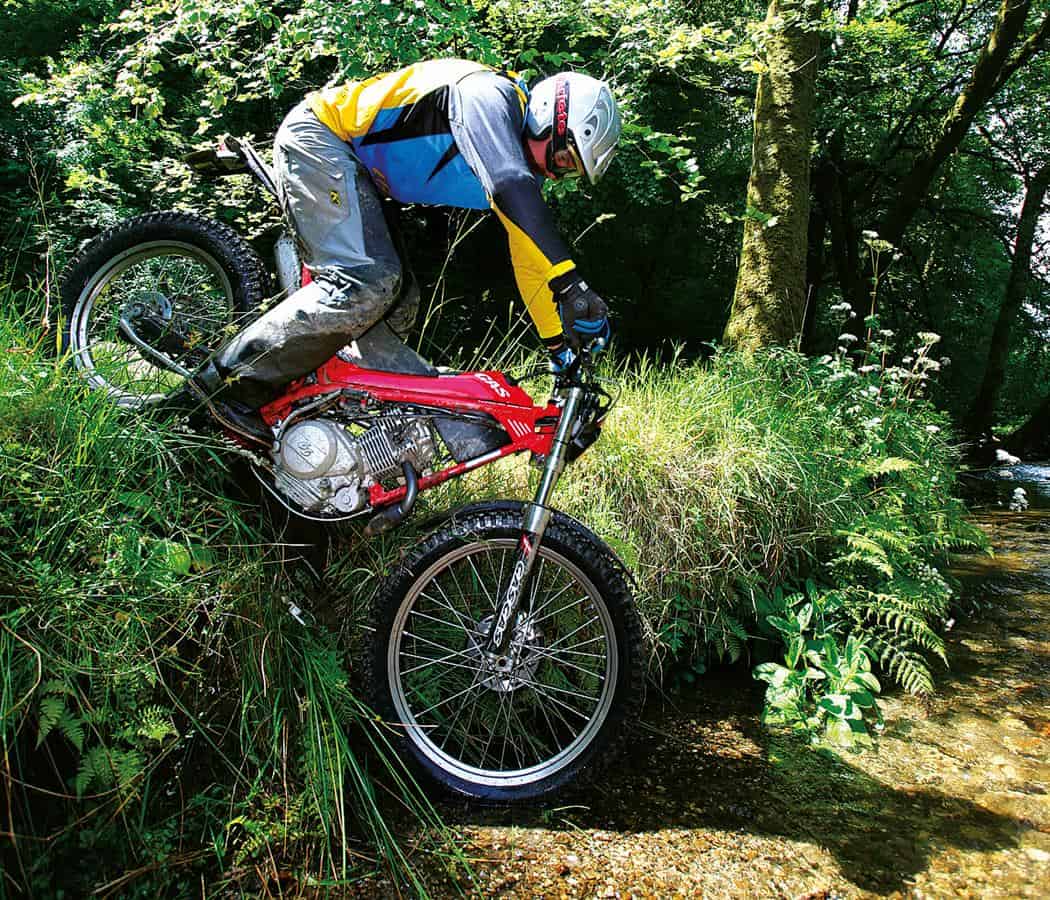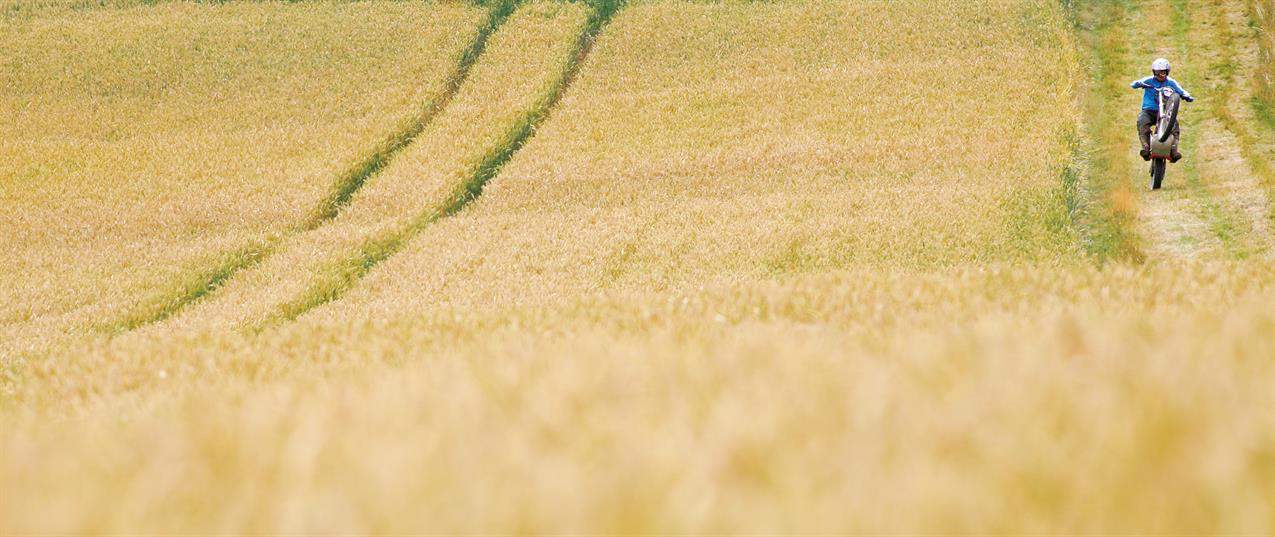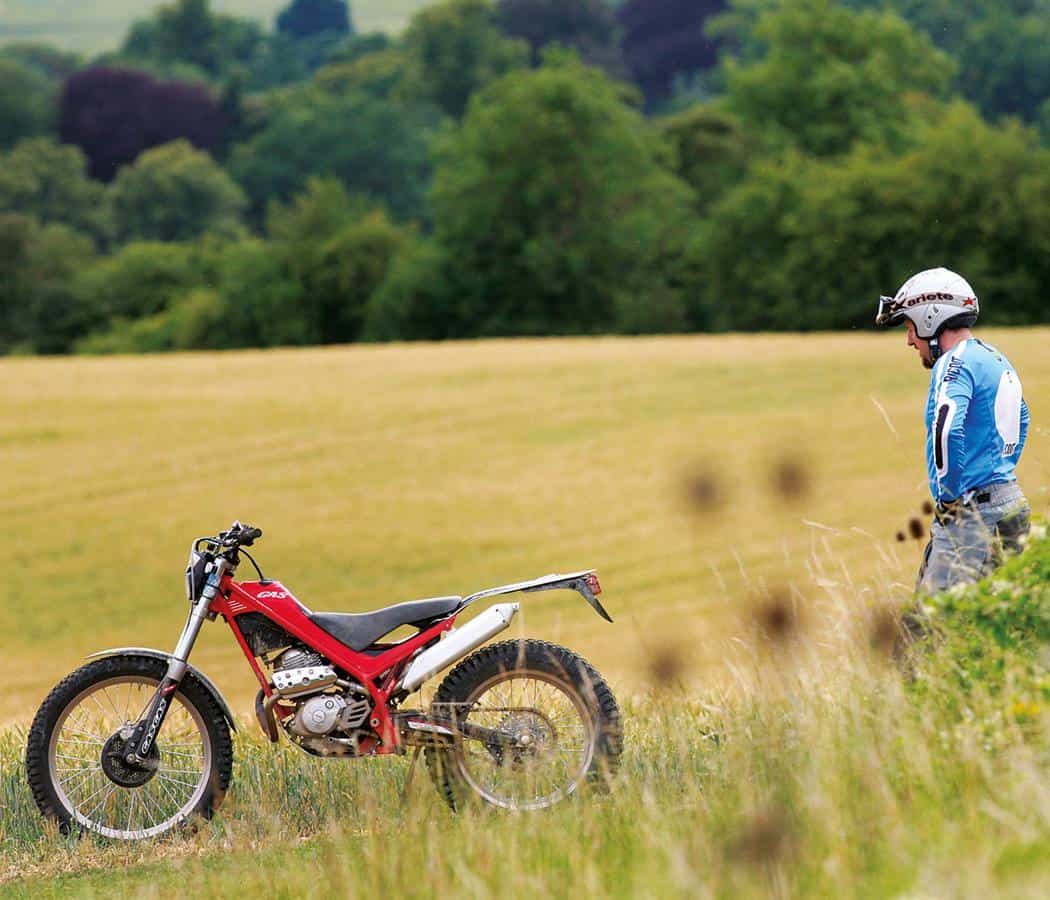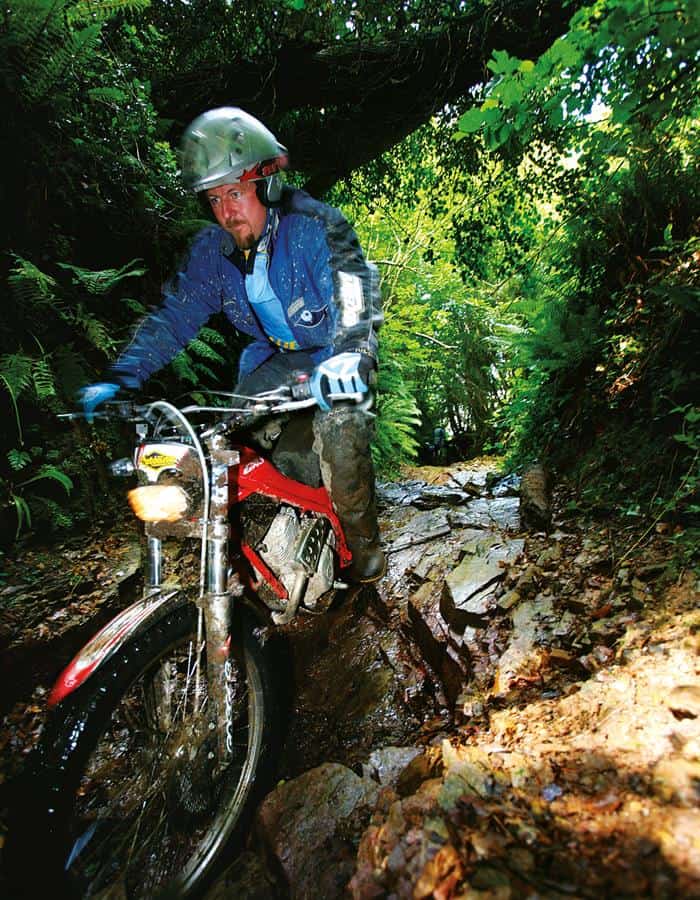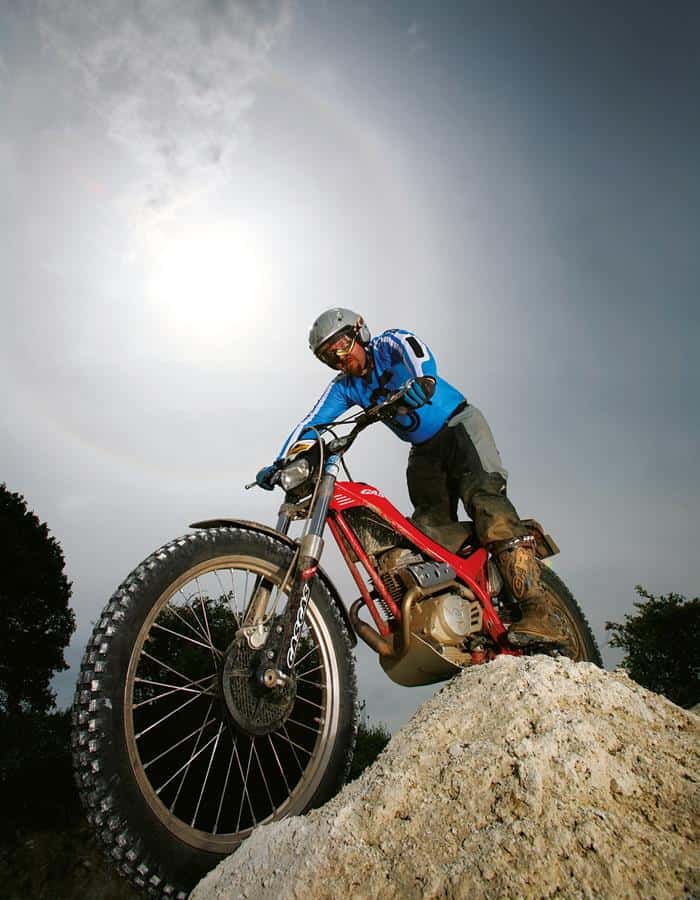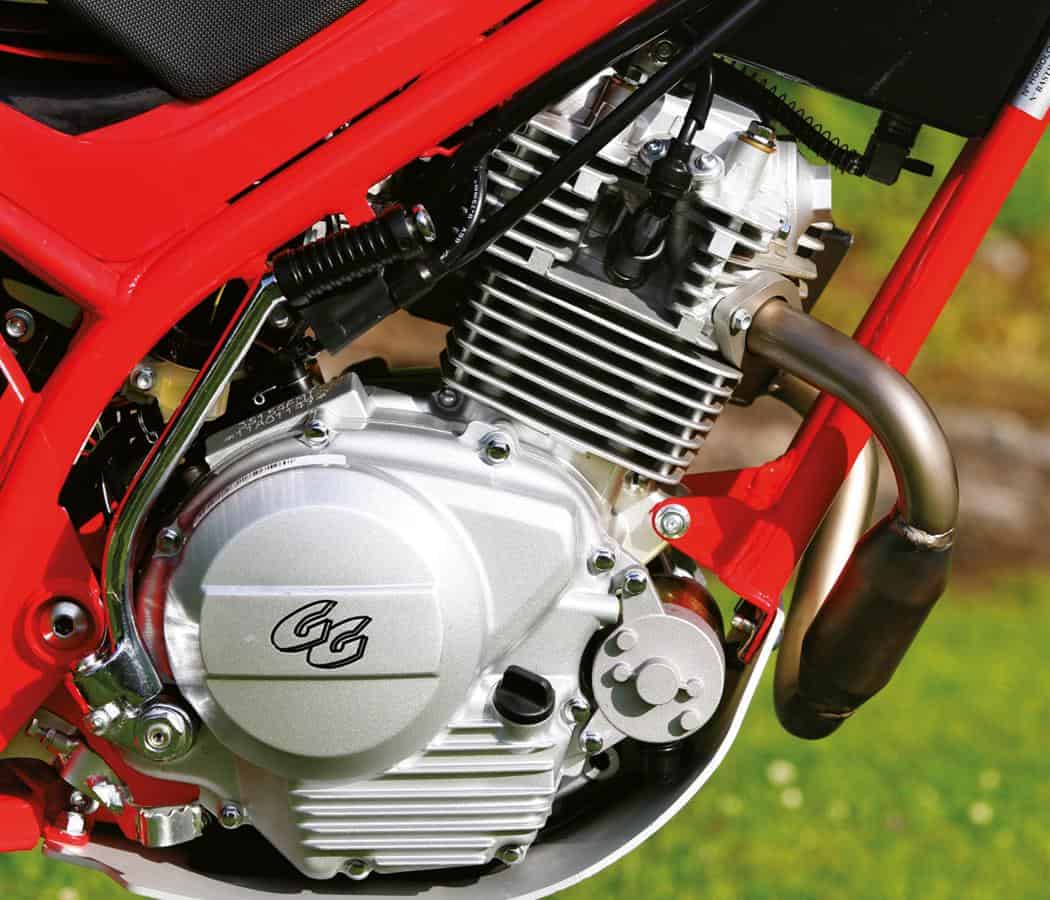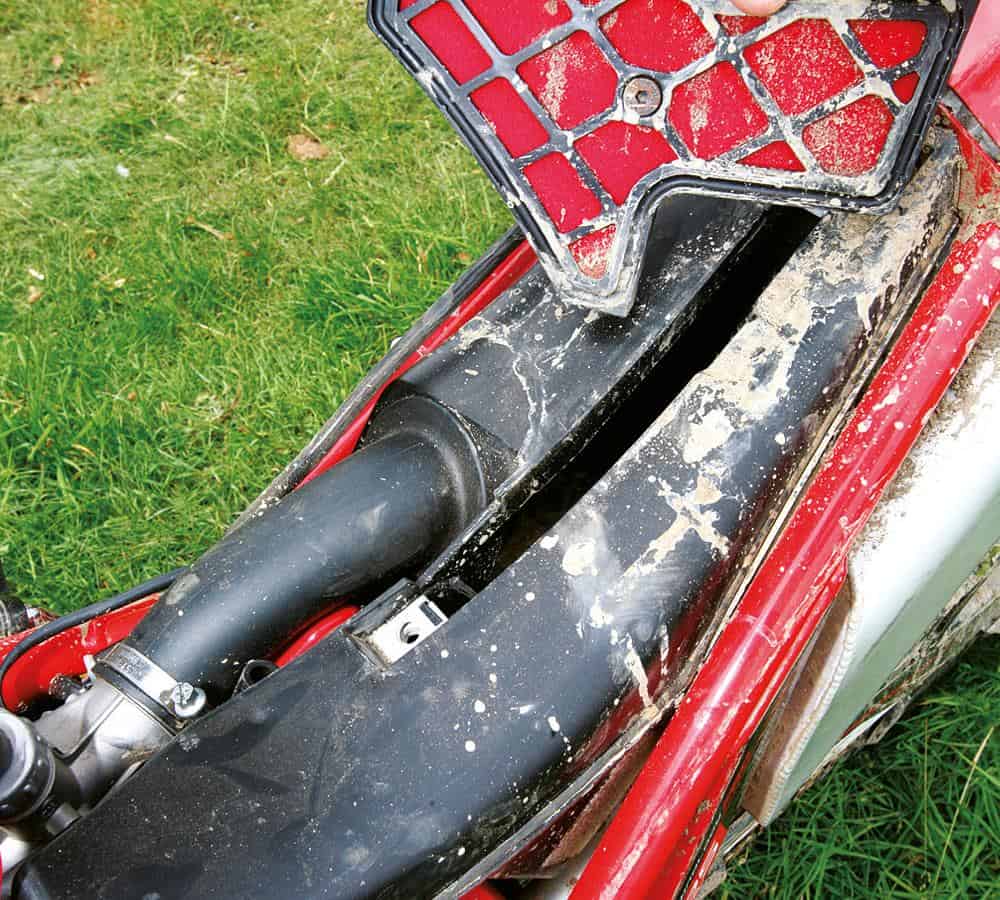Gas Gas’s Randonne 125 is the latest crossover-bike from the Spanish manufacturer. Hard to classify, but a hell of a lot of fun…
Sometimes a new bike comes along that is hard to classify in conventional terms because it simply doesn’t fit the mould of a stereotypical dirt bike. One such machine is the new Gas Gas Randonne. Is it a trail bike, a trials bike, a learner bike or something suitable for use in Long Distance Trials? Well actually it’s all these things and more besides…
When we first saw pictures of the Randonne 125 it piqued our interest not least because we’ve been waiting for a replacement for the defunct Gas Gas Pampera to come along for a while now, but also – frankly – because of its price: a lowly £2999 (in 2011). With new bikes currently costing north of five, six, or even seven grand, finding a brand new machine at less than half that price… well that’s an attention grabbing headline. Okay I realise that the Randonne is ONLY a modest 125cc four-stroke, so it’s hardly going to replace your WR450F, but at that kind of money there’s a number of RUST Hard readers that’ll be interested in owning one ALONGSIDE their existing trail or enduro bike – particularly if they can justify buying it for a number of different reasons.
So what good reasons are there for owning a Randonne? Well here’s a few for starters… It’s low enough and light enough to be handled by a beginner or someone who wants to try their hand at off-roading, like a spouse or teenage daughter for example. And though it has the advantage of being a learner-legal ride, it’s still very much a full-size machine for an experienced rider to play about on and enjoy….
Naturally it’s just about perfect for Long Distance Trials, in fact it’s actually a very competent little trials bike (albeit a fairly low powered one) that could easily be entered in a club trial, providing you ride the easy route. Obviously the trail saddle can be removed to make it even easier to move about on, but even with the seat in place you can tell that it’s set up like a trials bike, and for LDTs that makes it almost the perfect machine. It doesn’t have heaps of power but it will tackle even large rock-steps and slippery slabs (in first gear), and it has just enough performance to enjoy the rest of the ride….
It’s an economical commuter on which to make short journeys (anything up to about 10 miles on tarmac I reckon before you succumb to a combination of boredom and/or numb bum), and the quiet and refined Yamaha engine will return around 85+ mpg in mixed going, making it considerably cheaper to run than practically any other vehicle. On its stock gearing (it comes with two sets of sprockets) it’s absolutely ideal for the road and trail, provided you don’t want to travel faster than about 50mph. Not only is the gearing well judged for road and trail use, but the gear ratios are nigh-on perfect too with sensible gaps between ratios. Ridden gently it will better 100mpg.
We didn’t ride it with the alternative lower gearing but set up like that it’ll allow you to make more use of the gearbox off-road and give you a slightly better choice of ratios on the dirt, albeit at the expense of road speed and economy.
Gas ‘n’ Air
Ever since the death of Gas Gas’ Pampera models, certain riders have been casting around for a lightweight, manoeuvrable little trail bike that can distinguish itself at Long Distance Trials. It’s a small sector of the market admittedly, but one that’s poorly catered for, and which Gas Gas have pretty much had to themselves. These are the riders at whom bikes like the Yamaha Serow, Beta Alp or Scorpa T-Ride are aimed, but none of these machines is really a match for the Randonne in terms of tackling a green lane ‘section’.
That’s because unlike the other models the Randonne is basically designed as a trials machine first, and a trailie second. Obviously it’s not a competition model, more like a trials bike for beginners, but nevertheless the geometry and ergonomics are more or less those of a modern trials bike: the pegs are rear-set, putting most of your weight at the back of the bike where it has most effect, and meaning that the front wheel ‘rides very light’. And you lean your body forward in that typical trials-like stance.
There is what looks to be a slightly engorged fuel tank sat between the top frame rails and while this only holds a meagre four litres of fuel that’s theoretically good enough for about 75-80 miles of riding. Or at least it would be were it not for the fact that the fuel line goes uphill (from the base of the tank over the top of the engine) meaning that the last half litre of fuel is likely to remain little more than ballast.
Obviously modern triallers don’t have any sort of seat because you don’t sit down on them, but this being a hybrid trialler/trailie there’s a stepped saddle suspended across the middle of the machine like a bridge for when you want to sit down on the road between trails. I had worried that this seat which looks a bit like an afterthought would force you into the ‘birthing position’ making you the butt of all jokes among your riding mates, but that turns out not to be the case at all. It’s not particularly comfortable I grant you – it’s a bit too narrow for that – and you do need to sit on the rear hump rather than in the front position, but it’s more than tolerable for shortish stints in the saddle and actually much better than it looks.
So the Randonne has a trials-type steel chassis from which is suspended a little air-cooled Yamaha TT-R125 engine. Make no mistake this is a brilliant little lump. Quiet, smooth, narrow, refined and remarkably willing given its meagre capacity. Scorpa use the same engine in one of their junior trials bikes and of course it’s been used to power the TTR125 trailie/playbike and various other machines for a number of years so it has a proven pedigree in this sort of application. It is quite frankly a brilliant little motor and what it lacks in cubes it more than makes up for in the way it develops its power in a grunty little way. It doesn’t like stalling (which is good on sections and especially so for novices) so there’s no real need to keep it revving, just keep a (watchful) finger on the clutch and let the motor get on and do its thing.
The bottom of the motor is well protected – by the way – by a thick/smooth trials-style alloy sump-plate, which not only allows it to rock its way over fallen logs, but should also ensure no harm ever comes to the engine. We like that.
We also like the weight. The Randonne tipped the digi RUST scales to the tune of just… 88kg. That’s downright featherweight for a trailie, and not too shabby for a trialler either – especially one that has full road legality, a proper seat, a full tank of fuel and a four-stroke engine. No wonder it’s so easy to chuck around.
Long Way Down
We chose Cornwall as the location to test the Gas Gas Randonne, where the lanes are sometimes steep, often rock-lined and indeed slippery – a good combination, and a great challenge for a little 125 thumper. In RUST’s eyes at least, the South West Peninsular is the spiritual home of Long Distance Trials (LDTs) as it’s where most of the remaining events still take place (though there are some notable exceptions of course). Sometimes called classic trials or road trials these events are a throwback to the old-fashioned time-and-reliability trials which were the precursor to today’s modern trials, and arguably marked the birth of competitive motorcycling itself.
Although the format has barely changed in almost a century, these days the machinery is considerably more reliable so the emphasis is about maintaining feet-up riding and thus it pays to have more of a trials-type motorcycle which is light, highly manoeuvrable and easy to balance.
And that’s precisely the nature of the Randonne, and as a consequence the more gnarly the trail gets, the more fun it is to ride. Because while it’s perfectly happy to scoot along regular green lanes punctuated only by the odd muddy rut, throw in a few rather more technical hazards – a slippery descent over slabs or a rockstep or two – and the bike is absolutely mustard. Its design and shape allowing you to really work it using your body to shift weight about until you find grip. And while it’s not particularly fast per se, it can still maintain a decent pace along a lane thanks to being able to overcome pretty much all the hazards so easily.
If you’ve never ridden a trials bike before, the riding position does feel slightly alien at first – what with most of your weight towards the back of the machine and your arms stretched out slightly to reach the bars. It’s no great problem even for someone with short arms, in actual fact the Randonne is quite small and compact compared with a regular trailie, it’s just that the riding position feels slightly odd alongside a more conventional trailbike that’s all.
Other things you notice are the tucked in rear-brake lever (no problem), the sticking out kickstart lever (bit of a compromise) and the forward mounted gearshift lever which is best operated with the heel of your boot rather than your toe. That’s because trials riders don’t want the danger of accidentally stepping on the lever and changing gear mid-section, so the gear lever is positioned slightly further forward to avoid this happening. It’s not a problem and I daresay you could revert back to a shorter lever if it bothered you. I simply changed gear with my heel most of the time and it wasn’t an issue.
On that subject however, the little TT-R lump has a good ‘n’ solid (if slightly deliberate) gearchange which responds best to positive movements. Be firm and you won’t have a problem. One thing I didn’t like however was that the electric-start only works when the bike’s in neutral. Come to a halt in gear as you most often do, and you’ll be left having to search for neutral before you can get going again whilst all your mates tear off into the distance. Of course I’d love to say you can simply fold out the kickstart and boot it into life… but you can’t. Because while it doesn’t take much of a kick to get the Randonne going again. It does usually require that the right peg is folded up out of the kickstart’s way first in order to push the lever through its full stroke. But of course the peg is on a spring… so it won’t stay up!
If it was mine I’d take the kickstart off altogether because you simply don’t need it with the electric-start (you can easily bumpstart the bike too), and most of the time it just presses into your leg and gets in the way.
It’s this sort of annoying little detail that seems to let Spanish machinery down compared with other European or indeed oriental tackle. And while it’s not that hard to fix (by removing the peg’s spring, or fitting slightly different shaped pegs, or as I say by removing the kickstarter), you simply cannot imagine the Austrians or Japanese ever signing-off a bike like that. It just wouldn’t happen.
It’s only a small point and one that doesn’t really detract from the riding experience as a whole because chances are you’ll never need the kicker, but it’s infuriating nonetheless. Slightly less annoying but still a bit awkward is the needle-nosed right-side kick-stand (it’s a trials thing) that allowed our test bike to fall over all by itself; the flappy and unsupported rear fender which itself is supporting an ancient rear lens unit, two indicators and a number plate (boing, boing), and the fact that the second the bike went near water any deeper than a tadpole’s back legs… it cut out.
Removing the seat and then the body plastic and rear fender gives access to the airbox and what we found made my blood run cold. The airbox/filter/battery compartment is a brilliant example of clever packaging which deserves praise. And there’s a small but simple slot-in air filter, so far so good. Unfortunately because of the way the filter slots in vertically, there’s a danger of water leaking in from above and working its way down the carb side of the filter. To avoid this happening the Gasser is supposed to have a rubber seal on one side of the filter cage which prevents the ingress of water. I say ‘supposed to have’ because on our bike the rubber seal was missing and as a consequence water got in past the filter.
Okay a simple strip of gaffer tape across the top of the airbox will almost certainly kill the problem, but it’s disappointing to find things like missing seals on a new bike. And if I’m honest, even if the seal had been in place I’m not certain it would’ve prevented this happening because the gap between the filter itself and the airbox was kinda’ sizeable – broader than the width of a seal that’s for sure.
There are a couple of other little niggles worth a mention – both rear indicators won’t last five minutes off-road (both ours fell off), and the front right one is pushed out of place by the ignition barrel. The clutch cable chafes quite badly on the horn which sits behind the headlight, and the electronic speedo sender cable located on the rear wheel looks vulnerable to getting caught in the disc brake (it’s only held away by the caliper’s rubber bleed nipple cover).
Even collectively these things aren’t enough to put you off the bike (they’ll all be familiar problems to Gasser owners anyway), and while I’m sure the importer might argue that the cheap cost of ownership should mitigate any annoying niggles, I maintain that even cheap products oughta’ work correctly.
I don’t have any complaints with the way the bike rides though, as – aside from a too-softly damped rear shock (which you only really notice on harder hits, anyway), it all works splendidly. Interestingly the forks are adjustable but the shock is only adjustable for preload.
The Randonne is one of those bikes that always provokes a smile from whoever’s riding it. That’s because it performs better than you’d expect from a humble 125cc thumper. Because whilst I’d be lying if I said you don’t notice the bike’s limited reserves of power, I guess it’d be fair to say that with this bike you notice it less. That I reckon is down to the Randonne’s lightweight design and the fact that it allows you to do more (with less) than many more powerful trailies.
By more (with less) I mean it finds more grip, climbs more obstacles than more powerful trailbikes, and in some ways offers the rider a whole lot more fun at a fraction of both the purchase price and (more importantly) running costs of a bigger bike.
This last point is quite significant. I would expect a set of brake pads, chain and sprockets to last all year – maybe even longer depending upon usage. And of course it’ll consume less in terms of tyres, oil and fuel than an equivalent sized trailie. And while you might not go everywhere quite as quickly on the Randonne, there’s something to be said for this too. Of course everything is relative. If you’re a speed merchant or in any case the sort of rider that tramps on down the lanes then obviously the Randonne isn’t likely to be your cup of skinny latté. But if you’re a regular rider or a good-ol’-boy then it just might be.
The Randonne may not be quick but then it wasn’t built for speed it was designed to be agile, and that it most certainly is. It’s great fun clambering up banks, hopping over logs, turning feet-up around tight trees and urging the bike up ever more challenging hazards. We spent a day just messing around in a quarry and were amazed at what could be achieved on a bike with so little power.
The beauty of a bike like this is that it doesn’t need much land to have fun on, it’s exceptionally quiet and you could set out your own little obstacle course in a small plot of woodland if you were so inclined.
Of course you could do much the same with any trials bike but this is one you can also take trail riding with your mates on a 100-mile loop at the weekend, plus enter it in an LDT and hope to do fairly well on.
Quality Street
And now a word about Gas Gas quality – a touchy subject at the best of times. Developmental niggles aside (we’ve already talked about them), there doesn’t seem to be much wrong with the Randonne’s build quality, on the contrary it appears to be a nicely put together machine. It’s worth noting that items like the digital dials which used to be a Gas Gas weak point, are now one of the bike’s good features with an excellent display that’s easily readable on the move and now genuinely reliable.
The rest of the machine is equally well finished to be honest. The paint on the frame is thick (and there’s tiny stick-on frame protectors where you boots sit), the levers and other items all seem good quality and the robustness of the engine, bashplate and even items like the seat all seem to be decent quality for the asking price.
Let me remind you of the asking price… £2999. That’s a new bike for less than three grand. In real terms that’s probably one of the cheapest dirt bikes (from a known manufacturer) you’ll ever find. Looking on the Gas Gas website I note that it’s the same price as a TXT70 Rookie – a 70cc two-stroke novice bike. The cheapest full size (adult) bike is the PRO125 which at £4349 is a full 45 percent more expensive! And of course neither of these machines comes equipped for the road with dials or proper lights.
The Randonne then is remarkable value for money, but lest the importer reads this and decides to use it as leverage to ratchet up the price a little, let me say that at the three grand mark you are getting a nice little bike at the right money. Any more than three grand however and the cost/value equation takes a bit of a nose dive. It’s not that the bike isn’t worth 50 or 100 quid more, it’s that in this tough market there needs to be a bit of a ‘hook’ to tempt punters in and give people a reason to buy it. When the price begins with a 2, then that’s your hook. However once you enter the three-grand-and-above bracket, it just becomes another bike vying for your attention in an overcrowded marketplace.
We liked the Randonne a lot and and we had plenty of fun on it. I can definitely see a few riders taking a punt on it at that price. Sure there are one or two issues that need addressing, but a switched-on owner would sort those out. What happens if you’re not a switched-on owner is anyone’s guess. But at the price Gas Gas are asking, it seems a bloody good bike for the money…

